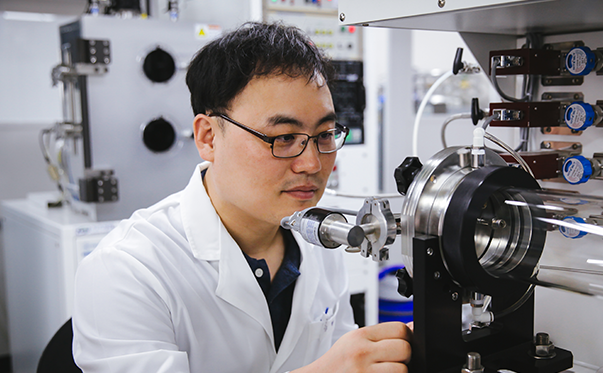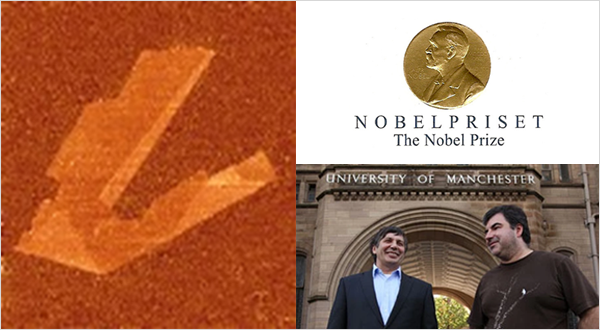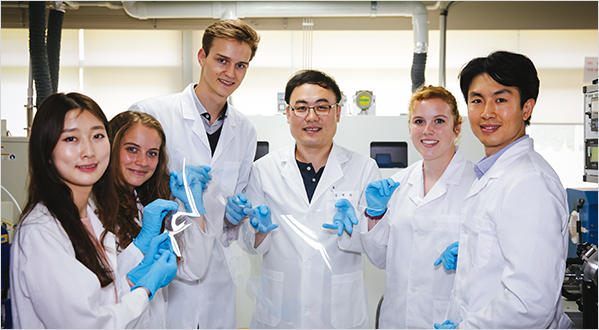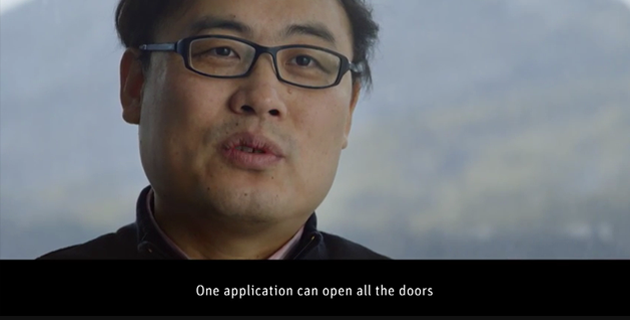
 <K. Novoselov, et al.> Science (2004)
<K. Novoselov, et al.> Science (2004)
 <Graphene Finally Goes Big> Science (2010)
<Graphene Finally Goes Big> Science (2010)
홍교수가 처음 제안한 CVD 그래핀합성에 대한 논문은 Nature지(Nature 457, 706(2009))에 수록되어 2009년 이후 현재까지 화학부문 세계 최다 피인용횟수를 기록하고 있습니다.
6,000+ 누적피인용횟수 (2009~)

1년 후 홍교수는 롤투롤 방식의 초(超)대면적 그래핀합성법을 개발하였고, 이를 통해 그래핀이 적용된 유연터치스크린을 제작해 선보였습니다.(Nature Nanotech. 5, 574-578 (2010)) 이는 그래핀을 응용한 전자기기의 최초 시제품으로 평가받고 있습니다.
4,000+ 누적피인용횟수 (2010~)


이러한 공로를 인정받아 홍병희교수는 노벨위원회로부터 노벨심포지엄에 강연자로 초청받게 되었고, 이는 2010년 노벨물리학상이 발표되기 약 5개월 전의 시점이었습니다.Royal Swedish Academy의 보도에 따르면 홍교수의 연구성과는 노벨상 수상에 결정적인 기여를 하였으며, 그 업적은 현재 노벨박물관에 전시되어 있습니다.
스웨덴 스톡홀름에 위치하여 알프레드 노벨의 생애(1833-1896) 및 노벨상 수상자들(1901~현재)에 대해 전시하고 있는 박물관


 서울대학교 자연과학대학 화학부 부교수
서울대학교 자연과학대학 화학부 부교수 http://www.graphene.re.kr
http://www.graphene.re.kr Employment
Employment
 Advisory Board
Advisory Board
 Journal Editor/Editorial Board
Journal Editor/Editorial Board
 Invited Talks
Invited Talks
 Honors
Honors
 Awards
Awards
 Journal Editor/Editorial Board
Journal Editor/Editorial Board
 Advisory Board/Project Committee
Advisory Board/Project Committee
 Conference Organizers/Symposium Chairs
Conference Organizers/Symposium Chairs
 Plenary/Keynote/Tutorial Talks
Plenary/Keynote/Tutorial Talks
 Invited Talks
Invited Talks


 서울대학교 자연과학대학 화학부 부교수
서울대학교 자연과학대학 화학부 부교수 http://www.graphene.re.kr
http://www.graphene.re.kr“Growth dynamics and gas transport mechanism of nanobubbles in graphene liquid cells,” Nature Commun. 2015, 6, 6068. “Graphene for displays that bend," Nature Nanotech. 2014, 9, 737-738. “Extremely efficient flexible organic light-emitting diodes with modified graphene anode,” Nature Photonics 2012 , 6, 105. “High-performance graphene-based transparent flexible heaters,” Nano Lett. 2011, 11, 5154. "Roll-to-roll production of 30 inch graphene films for transparent electrodes,” Nature Nanotech. 2010, 5, 574. (Cover Article) “Wafer-Scale Synthesis and Transfer of Graphene Films." Nano Lett. 2010, 10, 490-493. “Large-Scale pattern growth of graphene films for stretchable transparent electrodes,” Nature 2009, 457, 706. “Near-field focusing and magnification through self-assembled nanoscale spherical lenses,” Nature 2009, 460, 498. “Covalently bridging gaps in single-walled carbon nanotubes with conducting molecules,” Science 2006, 311, 356. “Ultrathin single-crystalline silver nanowire arrays formed in an ambient solution phase,” Science 2001, 294, 348.
View Scholar

 서울대학교 자연과학대학 화학부 부교수
서울대학교 자연과학대학 화학부 부교수 http://www.graphene.re.kr
http://www.graphene.re.kr 세계적 그래핀 전문가들이 말하는 홍병희 교수
세계적 그래핀 전문가들이 말하는 홍병희 교수

“산업계가 요구하는 것을 잘 몰라 한국의 홍 교수와 일하는 것이 도움이 됩니다.” - 2011 년 전자신문 특별대담 中 -“홍병희 교수의 상용화 연구 덕분에 노벨상을 일찍 탈 수 있었습니다.” - 노보셀로프 교수가 홍병희 교수에게 보낸 메일 -

"2010년 5월 노벨 심포지엄에서 홍병희 교수는 그래핀 대면적 합성기술과 터치스크린 기술을 시연, 그래핀의 미래를 보여줬다는 극찬을 받았습니다. 그 5개월 뒤 노벨상 발표가 났습니다"- 2011년 전자신문 특별대담 中 -

“홍병희 교수가 다른 나라의 제의를 다 마다하고 한국에서 그래핀 연구를 이어가서 기쁩니다. 모처럼 우리나라가 그래핀으로 소재 분야에서 앞서가고 있는데 그래핀스퀘어는 중요한 역할을 해낼 것입니다.” - 2012년 그래핀스퀘어 창립기념사 中 -

“제가 볼 때 한국의 그래핀 연구는 이 분야 선두에 있습니다. 홍병희 교수는 처음으로 그래핀 대량합성기술을 개발했는데 이는 굉장히 혁신적인 것이었죠. 사람들의 그래핀에 대한 개념을 바꾸어 놨어요. 실험실 안에서 재미있고 흥미롭던 소재가 갑자기 우리가 실생활에 쓸 수 있고 적용할 수 있는 소재로 바뀐 것입니다.”- 2015년 KBS 탄소혁명 中 -


 교수, 하버드대학교 물리학부
교수, 하버드대학교 물리학부 http://kim.physics.harvard.edu/
http://kim.physics.harvard.edu/Professor Kim is a world leading scientist in the area of materials research. His research area is experimental condensed matter physics with an emphasis on physical properties and applications of nanoscale low-dimensional materials. The focus of Prof. Kim’s group research is the mesoscopic investigation of transport phenomena, particularly, electric, thermal and thermoelectrical properties of low dimensional nanoscale materials. These materials include carbon nanotubes, organic and inorganic nanowires, 2-dimensional mesoscopic single crystals, and single organic molecules. The use of modern state-of-the-art semiconductor device fabrication techniques and the development of new methods of material synthesis/manipulation are essential parts of this research. He has initiated these efforts very successfully, and is continuously making innovations in microscopic experimental tools and methods in order to investigate the electric, thermal/thermoelectric transport properties of the nanoscale materials. Professor Kim published more than 120 papers in professional journals which are well cited. Many of his papers are published in high impact journals such as Nature, Science and Physical Review Letters. Professor Kim received numerous honors and award including Oliver E. Buckley Prize (2014), Loeb Lectureship, Harvard (2012); Dresden Barkhausen Award (2011); Yunker Lectureship, Oregon State University, (2011); Chapman Lectureship, Rice University, (2009); IBM Faculty Award (2009); Ho-Am Science Prize (2008); American Physical Society Fellow (2007); Columbia University Distinguished Faculty Award (2007); Recipient Scientific American 50 (2006); National Science Foundation Faculty Career Award (2004). In addition, He has given more than 300 invited presentations as keynote speaker, plenary speakers, and invited speakers in international and domestic conferences, colloquiums and department seminars.


 자연대 연구부학장
자연대 연구부학장 텍사스주립대학교(달라스)
텍사스주립대학교(달라스)Before joining U. T. Dallas in the Fall of 2003, Dr. Yang was in charge of leading Nano-Bio Business Development at the Samsung Advanced Institute of Technology (SAIT) as an Executive Vice President. SAIT is the Central R&D organization in Samsung Electronics. For 1997-99, he was the Head of Chemical Sector and Vice President at the Institute, and in February, 2000, he was promoted to an Executive Vice President in covering bio/chemical fields as CRO besides managing the Chemical Sector. Prior to Samsung, while employed at DuPont Company, he held various positions as a researcher, group leader, project/marketing manager at DuPont-U.S.A for 1978-95 and as Managing Director at DuPont-Korea for 1995-97. While at Dupont, he received various experiences through working in the several positions in R&D, manufacturing, supply chain, project/product management and sales/marketing at Polymer Intermediates Dept., Finishes/Fabricated Products Dept., Automotive Products SBU and Electronics Materials SBU. He was an adjunct professor at the Center for Surface Science and Engineering at University of Missouri at Columbia for 1989-93. He was also a founding member of Delaware Korean School and served as Managing Principle for 1993-5.